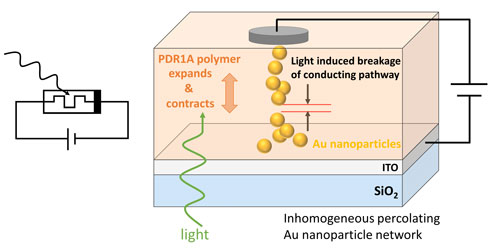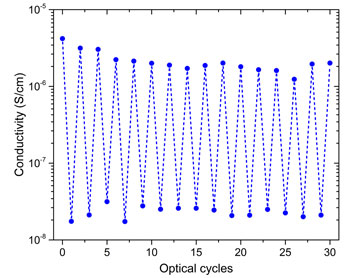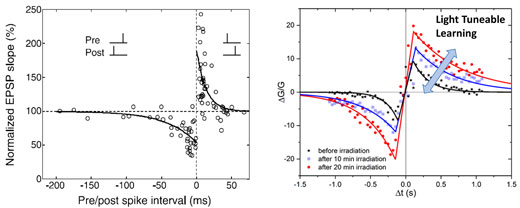| Jun 19, 2019 | |
Learning in artificial synapses tuned by light |
|
| (Nanowerk Spotlight) Memristor (or memory resistors) devices are non-volatile electronic memory devices that were first theorized by Leon Chua in the 1970’s. However, it was some thirty years later that the first practical device was fabricated. This was in 2008 when a group led by Stanley Williams at HP Research Labs realized that switching of the resistance between a conducting and less conducting state in metal-oxide thin-film devices was showing Leon Chua’s memristor behaviour. | |
| Since then the field has rapidly grown and there has been a huge amount of work in the area. Very high levels of endurance (120 billion cycles) and retention (10 years or more) have recently been achieved and ultrahigh density crossbar arrays, including multiple layer stacking, have been realized with scalability down to ∼2-10 nm. | |
 |
|
| Schematic of an optical memristor device. (Image: Dr. Neil Kemp, University of Hull) | |
| The high interest in memristor devices also stems from the fact that these devices emulate the memory and learning properties of biological synapses. i.e. the electrical resistance value of the device is dependent on the history of the current flowing through it. | |
| There is a huge effort underway to use memristor devices in neuromorphic computing applications and it is now reasonable to imagine the development of a new generation of artificial intelligent devices with very low power consumption (non-volatile), ultra-fast performance and high-density integration. | |
| These discoveries come at an important juncture in microelectronics, since there is increasing disparity between computational needs of Big Data, Artificial Intelligence (A.I.) and the Internet of Things (IoT), and the capabilities of existing computers. The increases in speed, efficiency and performance of computer technology cannot continue in the same manner as it has done since the 1960s. | |
| This is partly due to the inability to keep shrinking the size of transistors, but also, due to inherent bottlenecks in the von Neumann architecture of modern day computers and the way information is processed and transported between the CPU and memory. | |
| There is now a large effort underway to develop new computing architectures that remove some of these problems. One of these is in-memory computing, which as similarly done in the brain, is based on performing numerical and logical operations in the place where that information is stored in the memory. | |
| To date, most memristor research has focussed on the electronic switching properties of the device. However, for many applications it is useful to have an additional handle (or degree of freedom) on the device to control its resistive state. For example memory and processing in the brain also involves numerous chemical and bio-chemical reactions that control the brain structure and its evolution through development. | |
| To emulate this in a simple solid-state system composed of just switches alone is not possible. In our research, we are interested in using light to mediate this essential control. | |
| Previously we have shown how light can be used to control the learning properties of memristor devices ("Reversibly controlling the learning properties of memristors via optical means"). | |
 |
|
| Optical switching between electronic resistance states. (Image: Dr. Neil Kemp, University of Hull) | |
| We have demonstrated that light can be used to make short and long-term memory and we have shown how light can modulate a special type of learning, called spike timing dependent plasticity (STDP). STDP involves two neuronal spikes incident across a synapse at the same time. Depending on the relative timing of the spikes and their overlap across the synaptic cleft, the connection strength is other strengthened or weakened. | |
| STDP is known to occur in hippocampal neurons in the brain and is thought to be responsible for spatial awareness, reasoning and complex thoughts. | |
| In our work we have shown how light can modify the STDP learning properties of memristor synapses by enhancing or diminishing its sensitivity to the overlapping electrical impulses. In this way can tune how different neural networks respond for different functional needs. For examples we could make systems that are better suited for vision recognition and spatial awareness. | |
 |
|
| Left: Synaptic Learning in Biological Hippocampal Neurons (G.Q. Bi and M.M. Poo, J neurosci, vol. 18, pp. 10464-10472, 1998). Right: Light Tuneable Learning in Memristor Synapses. Light adjusts the sensitivity of the synapse to spiking (electronic) neuronal impulses which enhances or diminishes the memory (conductance) of the synapse. (Image: Dr. Neil Kemp, University of Hull) (click on image to enlarge) | |
| In our earlier work, we were only able to achieve to small switching effects in memristors using light. In our latest work (Advanced Electronic Materials, "Percolation Threshold Enables Optical Resistive-Memory Switching and Light-Tuneable Synaptic Learning in Segregated Nanocomposites"), we take advantage of a percolating-like nanoparticle morphology to vastly increase the magnitude of the switching between electronic resistance states when light is incident on the device. | |
| We have used an inhomogeneous percolating network consisting of metallic nanoparticles distributed in filamentary-like conduction paths. Electronic conduction and the resistance of the device is very sensitive to any disruption of the conduction path(s). | |
| By embedding the nanoparticles in a polymer that can expand or contract with light the conduction pathways are broken or re-connected causing very large changes in the electrical resistance and memristance of the device. | |
| Our devices could lead to the development of new memristor-based artificial intelligence systems that are adaptive and reconfigurable using a combination of optical and electronic signalling. Furthermore, they have the potential for the development of very fast optical cameras for artificial intelligence recognition systems. | |
| Our work provides a nice proof-of-concept but the materials used means the optical switching is slow. The materials are also not well suited to industry fabrication. In our on-going work we are addressing these switching speed issues whilst also focussing on industry compatible materials. | |
| Currently we are working on a new type of optical memristor device that should give us orders of magnitude improvement in the optical switching speeds whilst also retaining a large difference between the resistance on and off states. We hope to be able to achieve nanosecond switching speeds. The materials used are also compatible with industry standard methods of fabrication. | |
| The new devices should also have applications in optical communications, interfacing and photonic computing. We are currently looking for commercial investors to help fund the research on these devices so that we can bring the device specifications to a level of commercial interest. | |
| My overall motivation is to use nanotechnology to develop novel devices for use in real-world electronic applications. Increasingly the research in my group is moving towards artificial intelligence. Possibly, because I always have a deep-seated interest in understanding human intelligence and cognitive processes in the brain and how to emulate these in electronic systems. Very little is understood about how the brain perceives, stores and processes information. For me, understanding the human brain better is a key enabler to building better computing systems. | |
|
By Dr Neil Kemp, Senior Lecturer in the Department of Physics and Mathematics at the University of Hull
|
|
|
Become a Spotlight guest author! Join our large and growing group of guest contributors. Have you just published a scientific paper or have other exciting developments to share with the nanotechnology community? Here is how to publish on nanowerk.com. |
|
